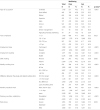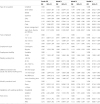http://stats.oecd.org/.
OECD statistics: .
ParkJ. LeeN. First Korean working conditions survey: a comparison between South Korea and EU Countries. Ind Health. 2009. 47(1):50–54. DOI:
10.2486/indhealth.47.50. PMID:
19218757.
DienerE. WirtzD. TovW. Kim-PrietoC. ChoiD. OishiS. Biswas-DienerR. New well-being measures: short scales to assess flourishing and positive and negative feelings. Soc Indicators Res. 2010. 97(2):143–156. DOI:
10.1007/s11205-009-9493-y.
AwataS. BechP. KoizumiY. SekiT. KuriyamaS. HozawaA. OhmoriK. NakayaN. MatsuokaH. TsujiI. Validity and utility of the Japanese version of the WHO-Five Well-Being Index in the context of detecting suicidal ideation in elderly community residents. Int Psychogeriatr. 2007. 19(1):77–88. DOI:
10.1017/S1041610206004212. PMID:
16970832.
Kamen-SiegelL. RodinJ. SeligmanME. DwyerJ. Explanatory style and cell-mediated immunity in elderly men and women. Health Psychol. 1991. 10(4):229. DOI:
10.1037/0278-6133.10.4.229. PMID:
1915208.
SegerstromSC. TaylorSE. KemenyME. FaheyJL. Optimism is associated with mood, coping, and immune change in response to stress. J Pers Soc Psychol. 1998. 74:1646–1655. DOI:
10.1037/0022-3514.74.6.1646. PMID:
9654763.
StoneAA. ShiffmanS. Ecological momentary assessment (EMA) in behavorial medicine. Ann Behav Med. 1994. 16(3):199–202.
DaraisehN. GenaidyA. KarwowskiW. DavisL. StamboughJ. HustonR. Musculoskeletal outcomes in multiple body regions and work effects among nurses: the effects of stressful and stimulating working conditions. Ergonomics. 2003. 46:1178–1199. DOI:
10.1080/0014013031000139509. PMID:
12933079.
KarlqvistL. TornqvistEW. HagbergM. HagmanM. ToomingasA. Self-reported working conditions of VDU operators and associations with musculoskeletal symptoms: a cross-sectional study focussing on gender differences. Int J Ind Ergon. 2002. 30:277–294. DOI:
10.1016/S0169-8141(02)00131-2.
StevensRG. HansenJ. CostaG. HausE. KauppinenT. AronsonKJ. Castno-VinyalsG. DavisS. Frings-DresenMHW. FritschiL. KogevinasM. KogiK. LieJA. LowdenA. PeplonskaB. PeschB. PukkalaE. SchernhammerE. TravisRC. VermeulenR. ZhengT. CoglianoV. StraifK. Considerations of circadian impact for defining 'shift work' in cancer studies: IARC Working Group Report. Occup Environ Med. 2011. 68:154–162. DOI:
10.1136/oem.2009.053512. PMID:
20962033.
OhayonMM. LemoineP. Arnaud-BriantV. DreyfusM. Prevalence and consequences of sleep disorders in a shift worker population. J Psychosom Res. 2002. 53:577–583. DOI:
10.1016/S0022-3999(02)00438-5. PMID:
12127174.
KahnH. CooperCL. Mental health, job satisfaction, alcohol intake and occupational stress among dealers in financial markets. Stress Med. 1990. 6:285–298. DOI:
10.1002/smi.2460060407.
KouvonenA. KivimakiM. VirtanenM. PenttiJ. VahteraJ. Work stress, smoking status, and smoking intensity: an observational study of 46,190 employees. J Epidemiol Community Health. 2005. 59:63–69. DOI:
10.1136/jech.2004.019752. PMID:
15598729.
LeeJ. LeeJ. An Analysis of the Structural Relationship Among Teachers' Autonomy, Optimism, Teaching Flow, and Well-Being. J Korean Teach Educ. 2011. 28(1):66–90.
http://www.kosha.or.kr/jsp/kwcs/index.do?fw=index&menuId=7598.
KWCS statistics 2011:
.
Birket-SmithM. RasmussenA. Screening for mental disorders in cardiology outpatients. Nordic J Psychiatry. 2008. 62(2):147–150. DOI:
10.1080/08039480801983562.
SchneiderCB. PilhatschM. RifatiM. JostWH. WodarzF. EbersbachG. DjundjaD. FuchsG. GiesA. OdinP. ReifschneiderG. WolzM. BottesiA. BauerM. ReichmannH. StorchA. Utility of the WHO‐five well‐being index as a screening tool for depression in Parkinson's disease. Mov Disord. 2010. 25(6):777–783. DOI:
10.1002/mds.22985. PMID:
20108365.
AllgaierA. PietschK. FrüheB. PrastE. Sigl-GlöcknerJ. Schulte-KörneG. Depression in pediatric care: is the WHO-Five Well-Being Index a valid screening instrument for children and adolescents? Gen Hosp Psychiatry. 2012. 34(3):234–241. DOI:
10.1016/j.genhosppsych.2012.01.007. PMID:
22325631.
AllgaierA. KramerD. SaravoB. MerglR. FejtkovaS. HegerlU. Beside the Geriatric Depression Scale: the WHO‐Five Well‐being Index as a valid screening tool for depression in nursing homes. Int J Geriatr Psychiatry. 2013. 28(11):1197–1204. PMID:
23463576.
ZierauF. BilleA. RutzW. BechP. The Gotland Male Depression Scale: A validity study in patients with alcohol use disorder. Nord J Psychiatry. 2002. 56(4):265–271. DOI:
10.1080/08039480260242750. PMID:
12470317.
DienerE. SuhEM. LucasRE. SmithHL. Well-being: Three decades of progress. Psychol Bull. 1999. 125(2):276. DOI:
10.1037/0033-2909.125.2.276.
Nolen HoeksemaS. JacksonB. Mediators of the gender difference in rumination. Psychol Women Q. 2001. 25(1):37–47. DOI:
10.1111/1471-6402.00005.
MroczekDK. KolarzCM. The effect of age on positive and negative affect: a developmental perspective on happiness. J Pers Soc Psychol. 1998. 75(5):1333. DOI:
10.1037/0022-3514.75.5.1333. PMID:
9866191.
Argyle M: Causes and correlates of happiness. In Well-being: the foundations of hedonic psychology. Edited by Kahneman D, Diener E, Schwarz N. Russell Sage Foundation; 1999:353. http://www.scholarpedia.org/w/index.php?title=Psychology_of_happiness&action=cite&rev=37099.
LepperHS. Use of other-reports to validate well-being measures. Soc Indicators Res. 1998. 44(3):367–379. DOI:
10.1023/A:1006872027638.
Koivumaa-HonkanenH. HonkanenR. ViinamäkiH. HeikkiläK. KaprioJ. KoskenvuoM. Self-reported life satisfaction and 20-year mortality in healthy Finnish adults. Am J Epidemiol. 2000. 152(10):983–991. DOI:
10.1093/aje/152.10.983. PMID:
11092440.
LangI. WallaceRB. HuppertFA. MelzerD. Moderate alcohol consumption in older adults is associated with better cognition and well-being than abstinence. Age Ageing. 2007. 36(3):256–261. DOI:
10.1093/ageing/afm001. PMID:
17353234.
Parent-Thirion A: 5th European Working Conditions Survey: Overview Report. Publications Office of the European Union; 2012. in press.
PetersonC. A primer in positive psychology. 2006. Oxford University Press, USA.







 PDF
PDF Citation
Citation Print
Print


 XML Download
XML Download